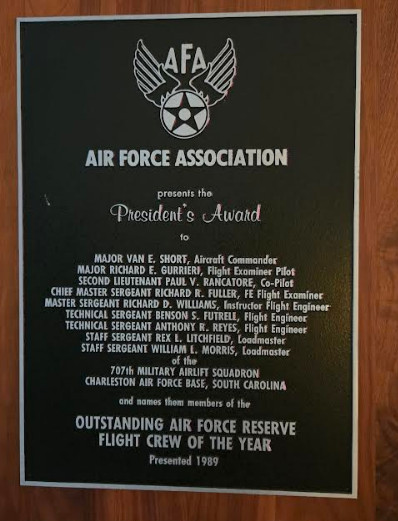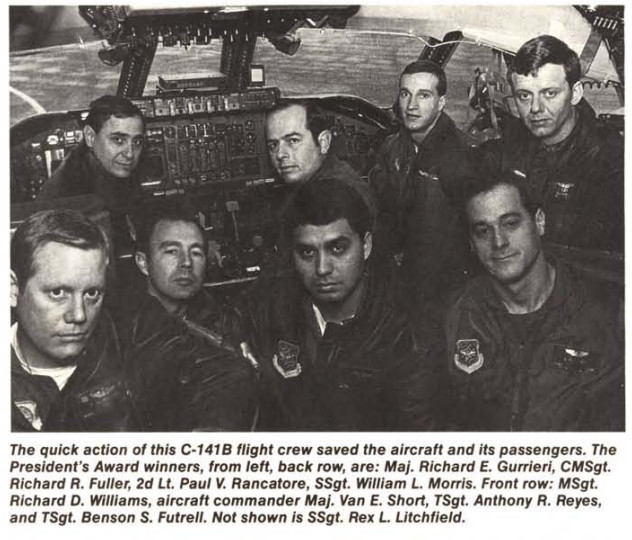T-Tail-Tall-Tail:
RAPID DECOMPRESSION
Jesse Short
My father (Van Short) was a C-141 pilot for his Air Force career. I believe it's the only airframe he flew while in the Air Force. His younger brother was also in the Air Force, originally as an F-4 weapons officer then also on C-141s and then finally C-17s.
From AIR FORCE Magazine / September 1989
All Air Force flight crew members who fly in pressurized aircraft
are required to go through altitude
chamber training periodically.
There's a good reason for this requirement. A sudden decompression at high
altitude can be fatal to
everyone on board. Quick crew reaction is essential.
Such an occurrence may be rare,
but it happened to Maj. Van E.
Short, aircraft commander of a
C-141B on a mission from Charleston AFB, S. C., to Ascension Island in the
South Atlantic last October. Major Short and his Reservist
crew are members of the 707th Military Airlift Squadron (Associate)
based at Charleston. The flight crew
that day consisted of Maj. Richard
E. Gurrieri, flight examiner pilot; 2d
Lt. Paul V. Rancatore, copilot;
CMSgt. Richard R. Fuller, flight engineer flight examiner;
MSgt. Richard D. Williams, instructor flight examiner;
TSgt. Benson S. Futrell,
flight engineer; TSgt. Anthony R.
Reyes, flight engineer; SSgt. Rex L.
Litchfield, loadmaster; and SSgt.
William L. Morris, loadmaster.
Also on board were fourteen passengers.
While cruising at 37,000 feet at
night over the Atlantic between
Antigua and Ascension, the aircraft
encountered severe clear-air turbulence. After a violent downward
jolt, the No. 1 engine compressor
stalled. The aircraft yawed to the
left, and the No. 4 engine also
stalled. A few seconds later, the No.
2 emergency hatch blew out, filling
the cargo compartment with fog,
debris, and horrendous noise. The
escape ladder was sucked out, damaging the fuselage and vertical stabilizer as
it flew by.
The report of the ensuing few
minutes shows the value of previous
training for just such emergencies.
Chief Fuller, who was sitting
next to the flight engineer panel, felt
that the aircraft was coming apart,
even though the cockpit entrance
door was closed, somewhat muffling the overall effects of the blowout.
Sergeant Williams, who had
been asleep in the crew loft just forward of the blown hatch, was dazed
but managed to climb down to the
cockpit before becoming incoherent and passing out. The crew
quickly found out that during a
rapid decompression, their time of
useful consciousness without pressurized oxygen was only about
seven seconds.
The pilots donned their masks,
pulled the engines to idle, and began
a descending right turn. The pilot
and flight engineer completed the
rapid-decompression checklist,
while the copilot attempted to contact [control centers] to declare an
emergency in uncontrolled airspace. There was no response.
Chief Fuller was pinned down by
Sergeant Williams, but managed to
reach another mask and used force
to hold it to Williams's face until he
recovered. At the same time, Sergeant Reyes,
the student flight engineer, administered oxygen to a
passenger in the jump seat who had
become unconscious.
Meanwhile, Sergeant Morris, one
of the loadmasters, had passed out
on the cargo floor, and the passengers
seated in the cargo compartment were
having life-threatening
problems. Some couldn't reach
their oxygen masks; some couldn't
get a good facial fit and were losing
vital pressure.
Sergeant Williams began filling
portable oxygen bottles with which
Chief Fuller and Sergeant Litchfield
tended passengers. Some were panicking;
three were slumped in their
seats; two more had passed out on
the cargo deck, one of them in
convulsions.
Major Short left the
flight deck with Major Gurrieri at
the controls and helped Sergeant
Morris recover. He then assisted the
fourteen passengers until all were
sitting up and giving the "thumbs
up" sign.
When the aircraft leveled off at
10,000 feet, the copilot radioed Ascension
Island and notified controllers that the
aircraft was returning to
Antigua, where Major Gurrieri
made the landing. As the report
states matter-of-factly, "As a result
of the crew's quick actions, no casualties or injuries resulted."

